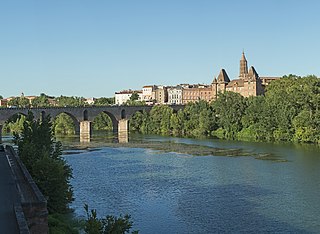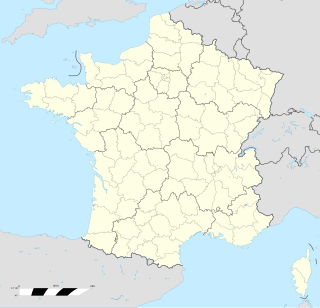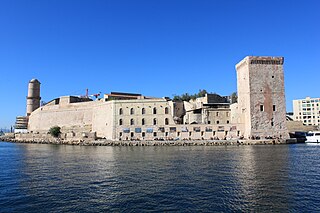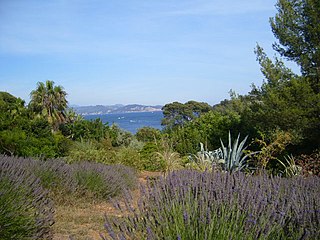
Montauban is a commune in the Tarn-et-Garonne department in the Occitanie region in southern France. It is the capital of the department and lies 50 kilometres (31 mi) north of Toulouse. Montauban is the most populated town in Tarn-et-Garonne, and the sixth most populated of Occitanie behind Toulouse, Montpellier, Nîmes, Perpignan and Béziers. In 2013, there were 57,921 inhabitants, called "Montalbanais". The town has been classified "Ville d’art et d’histoire" since 2015.

Aix-en-Provence, or simply Aix, is a city and commune in Southern France, about 30 km (19 mi) north of Marseille. A former capital of Provence, it is in the region of Provence-Alpes-Côte d'Azur, in the department of Bouches-du-Rhône, of which it is a subprefecture. The population of Aix-en-Provence numbers approximately 143,000. Its inhabitants are called Aixois or, less commonly, Aquisextains.

La Bastide-Clairence is a commune in the Pyrénées-Atlantiques department in the Nouvelle-Aquitaine region of south-western France.
Canton of Marseille – Saint-Marcel is a former canton located within the commune of Marseille in the Bouches-du-Rhône department of France. It was created 27 February 2003 by the decree 2003-156 of that date. It was disbanded following the French canton reorganisation which came into effect in March 2015.

The Old Port of Marseille is at the end of the Canebière, the major street of Marseille. It has been the natural harbour of the city since antiquity and is now the main popular place in Marseille. It became mainly pedestrian in 2013.
The Architecture of Provence includes a rich collection of monuments from the Roman Empire; Cistercian monasteries from the Romanesque Period, medieval palaces and churches; fortifications from the time of Louis XIV, as well as numerous hilltop villages and fine churches. Provence was a very poor region after the 18th century, but in the 20th century it had an economic revival and became the site of one of the most influential buildings of the 20th century, the Unité d'Habitation of the architect Le Corbusier in Marseille.

"Bastide" is a local term for a manor house in Provence, in the south of France, located in the countryside or in a village, and originally occupied by a wealthy farmer. A bastide is larger and more elegant than the farmhouse called a mas, and is square or rectangular, with a tile roof, walls of fine ashlar-stone sometimes covered with stucco or whitewashed, and often built in a square around a courtyard. In the 19th and 20th centuries, many bastides were used as summer houses by wealthy citizens of Marseille. More recently, most bastides in Provence have been transformed into expensive country homes.

La Bastide-de-Lordat is a commune in the Ariège department in the Occitanie region of south-western France.

La Bastide-de-Sérou is a commune in the Ariège department in the Occitanie region of south-western France.

La Bastide-sur-l'Hers is a French commune in the Ariège department in the Occitanie region of southwestern France.

Villefranche-du-Périgord is a commune in the Dordogne department in Nouvelle-Aquitaine in southwestern France.

Fort Saint-Jean is a fortification in Marseille, built in 1660 by Louis XIV at the entrance to the Old Port. Since 2013 it is linked by two thin bridges to the historical district Le Panier, and to the Museum of European and Mediterranean Civilisations, the first French national museum to be located outside Paris.

Parc Borély is a public municipal park in the city of Marseille, in France. It is classified by the French Ministry of Culture as one of the Notable Gardens of France. The park is 17 hectares in size. It adjoins the Jardin botanique E.M. Heckel.

The Jardin de la Magalone is public park and Garden à la française in the city of Marseille, France. It is listed by the French Ministry of Culture as one of the Notable Gardens of France.

The Gardens of Provence-Alpes-Côte d'Azur is a list and description of the parks and gardens in the region which are classified by the Committee of Parks and Gardens of the French Ministry of Culture as among the Notable Gardens of France.
The following is a timeline of the history of the city of Marseille, France.

The Musée des beaux-arts de Marseille is one of the main museums in the city of Marseille, in the Provence-Alpes-Côte d'Azur region. It occupies a wing of the Palais Longchamp, and displays a collection of paintings, sculptures and drawings from the 16th to 19th centuries.

The Museum of European and Mediterranean Civilisations is a national museum located in Marseille, France. It was inaugurated on 7 June 2013 as part of Marseille-Provence 2013, a year when Marseille was designated as the European Capital of Culture.




















